- Home
- Nicholson Baker
Double Fold Page 3
Double Fold Read online
Page 3
Amid the general devastation, there are some librarians of courage and foresight whose ccomplishments are as yet unsung. The Boston Public Library, owing to the belief of Charles Longley—the recently retired curator of microtexts and newspapers—that his institution’s accumulated newspaper files are “part of the City’s own heritage4 and the Library would be remiss in not retaining them,” not only has held on to all its existing collections but has continued to lay away all the recent output of Boston and selected Massachusetts papers, wrapped in brown paper, right up through the present; and the library has taken ownership of important sets of bound Boston newspapers once owned by Harvard and other libraries in the region as well. Longley was lucky: his views were shared by the city’s longtime librarian, the late Philip McNiff; often a change of administration proves fatal to a great collection.
At Ohio State, a librarian named Lucy Caswell, who wears quiet silk scarves and directs the Cartoon Research Library, is almost single-handedly attempting to rebuild a bound-volume collection of national scope—buying back for scholarly use material offered by dealers and collectors, most notably the lifetime harvest of Bill Blackbeard and his San Francisco Academy of Comic Art.
Several years ago, Caswell bought some volumes of the Chicago Tribune (from a dealer, who bought them from another dealer); two of them, one from 1899 and one from 1914, were out on a trolley at the Cartoon Research Library when I visited—four-inch-thick buckram-backed bulwarks, with heavy pull-straps triple-riveted to the binding in order to assist the frowning researcher in hauling their massiveness from the shelf. Their exteriors are scuffed and battered, but they are things of beauty nonetheless; they made me think of Mickey’s book of broom-awakening spells in Fantasia. I opened the volume from 1914. The inside boards displayed the seal of Harvard University, and below it I read:
FROM THE BEQUEST OF
ICHABOD TUCKER
[Class of 1791]
OF SALEM, MASS.
The paper wasn’t crumbling—it was easily turned and read. I called Harvard’s microform department and asked if they had the Chicago Tribune on paper from 1899 and 1914, just to be sure that the Ohio volumes weren’t from a duplicate set that they had sold. A sincere-sounding reference woman in the microforms department said, “Oh, we would never have hard copies going back that far—they just don’t keep.” They don’t keep, kiddo, if you don’t keep them.
Aside from what Lucy Caswell and Charles Longley have been able to save, the annihilation of once accessible collections of major daily papers of the late nineteenth and twentieth centuries is pretty close to total. Some state libraries—Pennsylvania’s, for instance, in Harrisburg—reached back further than the 1870s or 1880s as they designed their disposal programs, and used 1850 as a draconian dump-after date. “Pennsylvania was the first state to undertake statewide microfilming and destruction of its newspaper files,” Bill Blackbeard told me. “They did an extraordinarily, brutally thorough job of it. Unfortunately, some of the earliest color Sunday comic strips were printed in Philadelphia newspapers. So I never have gotten to see very many of those.” The State Library of Pennsylvania did not keep its original bound set of The Philadelphia Inquirer, and neither did the Free Library of Philadelphia—a librarian there wrote me that wood-pulp newsprint “falls apart.” Bell and Howell Information and Learning (formerly University Microfilms) will, however, sell the whole Inquirer to you on spools of archival polyester, encased in little white cardboard boxes, for $621,515.
Bell and Howell/UMI now owns microfilm negatives for most of the big papers in the country; and, to the extent that there are no originals left to scan when scanning resolution improves, its “master” microfilm (some of it inherited from now defunct filming labs and of poor quality) will perforce become the basis for any future digital versions of old newspapers, access to which the company will also control. Bell and Howell has successfully privatized our past: whether we like it or not, they possess a near monopoly on the reproduction rights for the chief primary sources of twentieth-century history.
Where did all the spurned papers go? Many were thrown out—and continue to be thrown out as statewide filming projects progress—but a colossal residue rests at a company called Historic Newspaper Archives, Inc., the biggest name in the birth-date business. If you call Hammacher Schlemmer, say, or Potpourri, or the Miles Kimball catalog, to order an “original keepsake newspaper”5 from the day a loved one was born, Historic Newspaper Archives will fill your order. In the company’s twenty-five thousand square feet of warehouse space in Rahway, New Jersey, innumerable partially gutted volumes wait in lugubrious disorder on tall industrial shelves and stacked in four-foot piles and on pallets. I paid a visit one winter afternoon. The Christmas rush was over, and the place was very quiet. Torn sheets, sticking out from damaged volumes overhead, slapped and fluttered in a warm breeze that came from refrigerator-sized heaters mounted on the ceiling. When an order came in for a particular date, a worker would pull out a volume of the Lewiston Evening Journal, say (once of Bowdoin College), slice out the issue, neaten the rough edges using a large electric machine called a guillotine (adorned on one side with photos of swimsuit models), and slip it in a clear vinyl sleeve for shipping. Every order comes with a “certificate of authenticity” printed in florid script.
Not everything was on shelves—some were piled three pallets high against the wall; and the University of Maryland’s large collection, a recent arrival, occupied about a thousand square feet of floor near the loading dock. The Herald Tribune set that the Historic Newspaper Archive is gradually dismembering is bound in pale-blue cloth and is in very good condition (where it hasn’t gone under the knife, that is); its bookplates announce6 that it was the gift of Mrs. Ogden Reid, who owned and ran the Tribune, more or less, in the forties and fifties. It is a multi-edition file: five editions for each day are separately bound. I would guess that this was at one time the Herald Tribune’s own corporate-historical set; Mrs. Reid no doubt believed that she was ensuring its careful continuance by donating it to a library. Hy Gordon, the no-nonsense general manager of the archives, told me that he believes he got his Herald Tribunes from the New York Public Library. Gordon sold me one volume from the set, for February 1–15, 1934 (including rotogravure sections and color cartoons by Rea Irwin) at a discounted price of three hundred dollars plus shipping.
(The NYPL divested themselves of their Tribune run, but it must be commended for keeping a huge cobbled-together set of The New York Times, from 1851 right up through 1985, several decades of which exist in a special rag-paper library edition. They will let you read from it in room 315, where they serve “semi-rare” material under supervision. The run has some gaping holes—for instance, there are no volumes at all for the years from 1915 through 1925. And no research library, I believe, has saved the Times in paper over the past decade: the paper now prints thousands of color photographs a year, but you wouldn’t know that from the film.)
I told Hy Gordon that I thought some librarians had exaggerated the severity of newsprint’s deterioration. “Oh yeah, yeah, it doesn’t fall apart,” he agreed. “The ends might crack, but that’s all. The newspaper’s still fine.”
I said I was distressed that so many libraries were getting rid of their bound newspapers.
“Don’t be distressed,” he said. “There are a lot of things more important in life.”
Are there really? More important than the fact that this country has strip-mined a hundred and twenty years of its history? I’m not so sure. The Historic Newspaper Archives owns what is now probably the largest “collection” of post-1880 U.S. papers anywhere in the country, or the world, for that matter—a ghastly anti-library. They own it in order to destroy it. “Here are rare and original newspapers with assured value many from the Library of Congress,” says the Archives’ sales brochure—all for sale for $39.50 an issue.7 I saw identifying bookplates or spine-markings from the New York State Library, the New York Public Library, Brown University, t
he San Francisco Public Library, Yale, the Wisconsin Historical Society Library, the American Antiquarian Society, and many others. A now mutilated run of the New York World has this bookplate:
Presented to
THE NEW-YORK HISTORICAL SOCIETY
by
THOMAS W. DEWART
former President of The Sun
and by
ROY W. HOWARD
President and Editor of the
New York World-Telegram and The Sun
And there was a shelf of volumes bearing this warning:
THESE FILES ARE FOR
PERMANENT RECORD OF
The St. Louis Republic
HANDLE WITH CARE
Positively Must Not be Cut
or Clipped
The warning has not been heeded.
CHAPTER 3
* * *
Destroying to Preserve
In April 1999, a few months after my visit to Hy Gordon’s warehouses in Rahway, I first came across a brief description of the British Library’s disposal project on their website. I was trying to find out whether European libraries keep the originals of their own domestic newspapers after they have microfilm backups made. (They often do;1 in fact, the British Library, to its great credit, still binds the big English dailies, like the Telegraph and the Guardian. Many American newspaper librarians would view that activity as eccentric and pointless.) Papers of “special historical importance or illustrative interest are not included in the disposals project,” I read—but that couldn’t be right, since on the accompanying list was the World, the Chicago Tribune, The New York Times, the Herald Tribune, the New Orleans Times-Picayune, Hearst’s New York American (only two years of it, though), the St. Louis Globe-Democrat (during the period that Theodore Dreiser wrote a column for it), the Philadelphia Public Ledger, and other major dailies. Each of these runs is of historical importance, needless to say, and some of them are bursting with illustrative interest. And each one has now, thanks to decades of copycat self-plunder in U.S. libraries, reached an almost unimaginable state of artifactual scarcity.
I called up a friendly-sounding person named Bhavna Tailor, who is in charge of Acquisitions and Stock Control at the British Library’s Newspaper Library (“stock control,”2 I have since learned, is English librarianship’s gentle phrase for “getting rid of the stuff you don’t want”), and I did my best to convey to her the preciousness of the things on her disposal list, and the mediocrity of some of the microfilm copies in which the library was placing its trust. The same day, I e-mailed her a letter. “My hope is that this extraordinary trove can be kept intact and available for future scholarship,” I said, “not cut up and sold piecemeal by dealers.” I would be willing to pay for removal and storage if I had to, I told her, either via a non-profit or as a private citizen, if it came down to a choice between that and seeing the papers irretrievably dispersed. Ten days later, I got a response from Tailor. She would keep my letter on file, she said, “and if there are no takers for the remainder of the US titles, then I will contact you and we can take matters from there.” I forwarded the list to Lucy Caswell, because she was the only librarian I knew who was actively taking in large wood-pulp backfiles (as they’re called), but she was still trying to digest the tractor-trailer loads of bound volumes and single sheets that her library had bought from Bill Blackbeard.
In August, after sending two further notes of inquiry, I got a letter from the British Library, attached to which was a much longer disposal list, amounting to about a hundred and thirty newspapers and other miscellaneous periodicals—more than three times as many as had been specified in the library’s newsletter and on its website. The New York World was still there—unbelievably, no library had snapped it up—as were most of the other big papers; and there were pictorial vehicles, such as Leslie’s Illustrated Weekly and the Chicago Graphic, and a bewildering array of ethnic papers and periodicals (the Gaelic American from 1916 to 1919, the American Hebrew from 1905 to 1920, the Boston Dielli, the Jersey City Svoboda, the New York Irish World from 1880 to 1946, the British Californian, the Chicago Katolik, the New York Vienybe Lietuvninku, the France Amerique, and on and on); and political papers (the Yiddish Forward from 1917 to 1975, for instance, and the Worker from 1943 to 1968); and a number of uncommon trade periodicals such as Combustion and Fur Trade Review (both from the thirties). “It has been decided,” Bhavna Tailor stiffly wrote, “that it would not be appropriate for us to donate the remaining material to individuals rather than to institutions.” The material, she said, would be “offered to the highest bidder.” The list was evidently sent out to newspaper dealers at about the same time I got it; the deadline for bids was September 30, 1999.
As I stared at the titles, I felt a great wave of premonitory misery. The timing of this development was not good. I was two years behind in everything, I owed everybody letters of thanks, apology, correction, or friendly encouragement; and my wife and I had drained our cash reserves, having just bought an eighteenth-century house with no doorknobs in Maine. I didn’t want to get caught up in some kind of mind-consuming, hideously expensive wrangle with the British Library.
But, gee, the list was long. The library, while perhaps in technical compliance with disclosure rules, was trying to minimize the scope of their deaccessioning. And then there was the phrase “to the highest bidder.” Apparently, it was a matter of indifference to the library whether the newspaper collection held rarities or not; they were willing to act in a way that would all but guarantee its quietus at the hands of the paper knackers. They wanted the money. So I made calls, hired lawyers, wrote letters, formed a non-profit corporation, and appealed to the British Library’s sense of decency. It didn’t work.
The size of newspapers is indispensable to our experience of their content. The newspaper reader proceeds nonlinearly, not as he would holding a typical book, but circling around the opened double-page spread, perhaps clockwise, or counterclockwise, moving his whole head as well his eyes, guided by island landmarks like photos and ads. Even the papers that have no pictures at all have a visual exorbitance, a horizon-usurping presence that microfilm’s image (which one observer in the seventies compared to “kissing through a pane of glass”3) subverts and trivializes.
Still, there is nothing intrinsically wrong with microfilming. Taking tiny black-and-white pictures of things isn’t objectionable so long as the picture-taking isn’t destructive. In fact, microfilm can be extremely useful: it is portable and reproducible, and for many kinds of simple referential research, it can serve as a stand-in or buffer copy that reduces wear on irreplaceable and fragile originals. Nobody objects to postcards of Dürer woodcuts, or coffee-table books filled with reproductions of vintage ocean-liner posters, because the existence of handy copies of these works of art, in reduced size, does not induce museum curators to slice up or throw away the originals.
But the microfilming of old newspapers (which contain many thousands of woodcuts, by the way, not to mention Easter-egg cutouts, paper dolls, dress patterns, and illustrated sheet music) has, right from the beginning, been intimately linked with their destruction. The disbinding of every volume in order to speed production and avoid gutter shadow (the middle area of an open volume, where the pages turn down toward the binding, a region harder to light and keep in focus) has long been the preferred method of newspaper microphotography in the United States. (European microfilming is more likely to leave the bindings alone.4) The technique was systematically applied at the Library of Congress: Luther Evans, who had made a name for himself as head of the WPA’s Historical Records Survey,5 where in the thirties he supervised a large amount of nearly unreadable make-work microfilming around the country, and who eventually became Librarian of Congress, described a pilot project to film a run of the Washington Evening Star in 1941: “The entire back of the binding6 was sheared off under a power cutter and the pages photographed individually.” Evans called this “the ideal technique for microfilming bound newspapers.” S.
Branson Marley, a chief of the library’s Serials Division, wrote years later of that disbinding, “This was a major decision,7 for it meant that in order to film a file for preservation, it was necessary to destroy it; once the volumes were cut for this purpose it was impractical, and usually impossible, to restore them.”
That was the practical beginning of the idea of destroying to preserve, which has, thanks to the Library of Congress’s leadership, become all-powerful in U.S. libraries since the fifties. The notion that printing work of the highest level of technical sophistication, produced in four and five colors in multimillion-dollar plants tended by teams of pressmen working around the clock, would necessarily become the casualty of a crude, error-prone, parallax-warped miniaturizing process, was one that became very attractive to library managers, simply because they didn’t want to store the newspapers: newspapers take up lots of space, they are heavy to lug around (a typical ex-library volume weighs twenty pounds), and marginal bits flake off in a messy way, too.
Compared to storing the originals in some big building, microfilming is (like digitization) wildly expensive, even in high-contrast black and white—it costs over a hundred and fifty dollars per volume8 to film a typical newspaper collection, versus less than five dollars a volume9 to build outlying storage for it and hire a person to truck to-and-fro whatever people want to see. And newspaper pages are the most difficult of all printed artifacts to photograph (or digitize) well: they are very large, narrow-margined, and filled with tiny type and finely detailed line drawings and photography. You’re using the outside area of the lens, where distortion is higher; you’re shrinking very small things very small; and you’re removing “grayscale” nuances—of course you’re going to lose information, and beauty, in the process. Books and journals are easy to work with by comparison.

 House of Holes
House of Holes Checkpoint
Checkpoint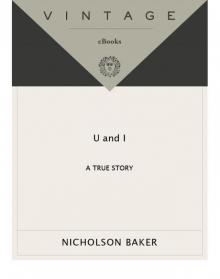 U and I
U and I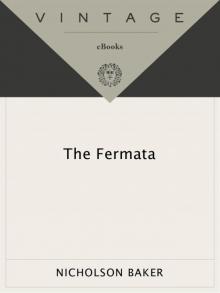 The Fermata
The Fermata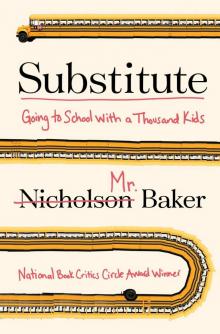 Substitute
Substitute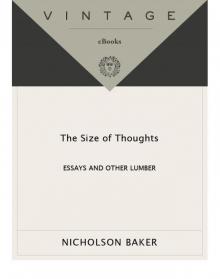 The Size of Thoughts
The Size of Thoughts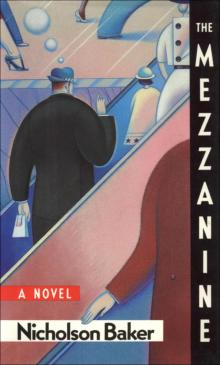 Mezzanine
Mezzanine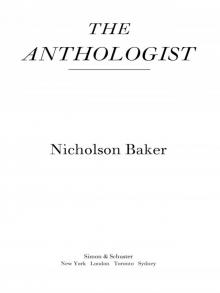 The Anthologist
The Anthologist Traveling Sprinkler
Traveling Sprinkler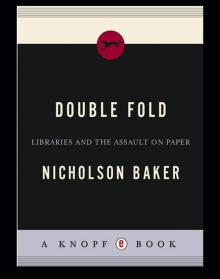 Double Fold
Double Fold The Everlasting Story of Nory
The Everlasting Story of Nory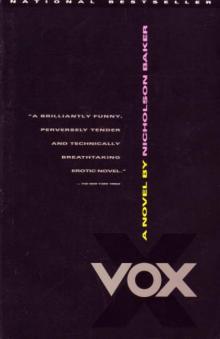 Vox
Vox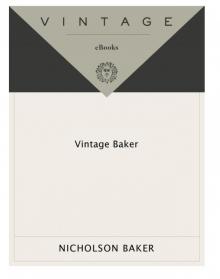 Vintage Baker
Vintage Baker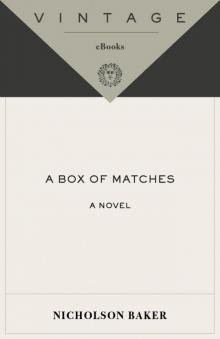 A Box of Matches
A Box of Matches